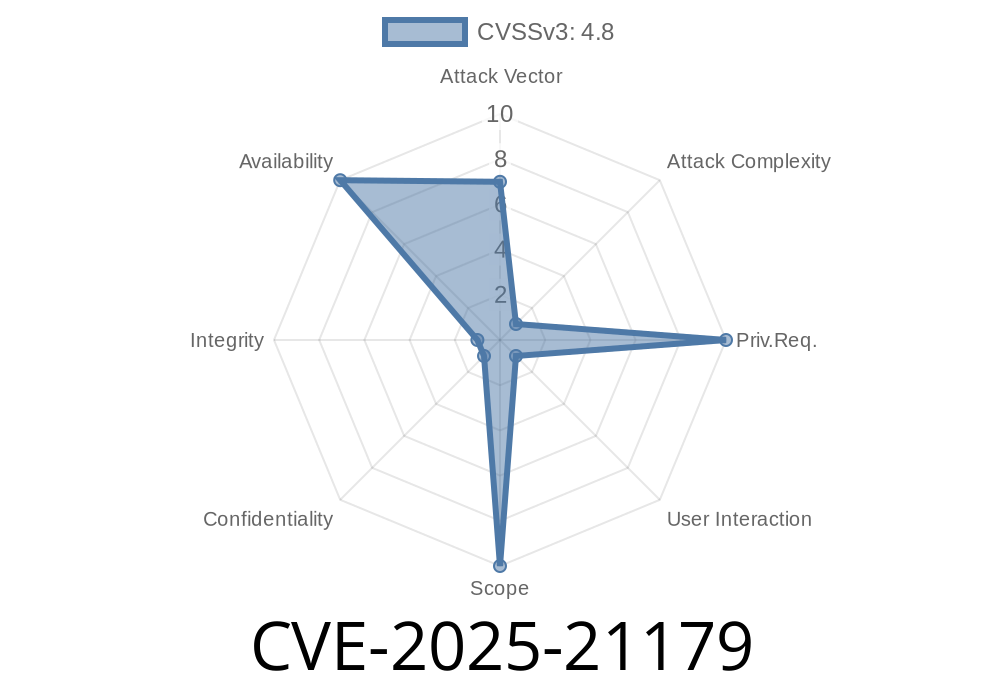CVE-2025-21179 is a recent vulnerability that affects the DHCP (Dynamic Host Configuration Protocol) client service in numerous systems and devices. This vulnerability allows a remote attacker to perform a Denial of Service (DoS) attack, causing severe interruptions in service and network access for end-users. In this article, we will take a deep dive into the exploit, understand its inner workings, examine some code snippets, and explore mitigation techniques. We'll also provide links to original references and resources for further study.
Background
Before we delve into the vulnerability details, it's important to understand what DHCP is and how it works. DHCP is a widely used network protocol designed to assign IP addresses and other network configuration settings automatically, making the process of connecting to a network as seamless as possible.
A DHCP client communicates with a DHCP server to obtain its IP address and other network configurations. However, the vulnerability (CVE-2025-21179) enables an attacker to purposely craft and send malicious DHCP responses, leading to a Denial of Service attack on the client devices.
Exploit Details
The root cause of CVE-2025-21179 lies in the way DHCP client software parses DHCP server responses. An attacker can exploit this vulnerability by sending specially crafted DHCP response packets that trigger a memory corruption in the client's DHCP implementation.
Here's a code snippet example that demonstrates how a malicious DHCP response can be crafted
import socket
def craft_malicious_dhcp_response():
# Craft a regular DHCP response packet first
response_packet = create_dhcp_response_packet()
# Add the malicious payload that exploits CVE-2025-21179
malicious_payload = b'\x00' * SOME_OFFSET + b'\xFF' * PAYLOAD_SIZE
response_packet += malicious_payload
return response_packet
# Send the malicious DHCP response packet to the target IP address
def send_malicious_dhcp_response(target_ip):
s = socket.socket(socket.AF_INET, socket.SOCK_DGRAM)
s.sendto(craft_malicious_dhcp_response(), (target_ip, DHCP_CLIENT_PORT))
# Example usage
send_malicious_dhcp_response('192.168..1')
In the code snippet above, the craft_malicious_dhcp_response() function first creates a regular DHCP response packet. Next, it appends a malicious payload, causing memory corruption when processed by the client's DHCP implementation.
Original References
For more detailed information on the CVE-2025-21179 vulnerability, its impact, and affected systems, refer to the following resources:
1. Official CVE-2025-21179 Vulnerability Details
2. National Vulnerability Database (NVD) Entry for CVE-2025-21179
3. Vulnerability Researcher's Blog Post on CVE-2025-21179
Mitigation Techniques
The best defense against CVE-2025-21179 is applying available security patches and updates, ensuring client systems have the most up-to-date software and are immune to this specific vulnerability. However, here are some additional tips and guidelines to secure your DHCP clients:
1. Use separate VLANs for data and management traffic to minimize the risk of rogue DHCP servers sending malicious responses.
Employ host-based firewalls to restrict incoming traffic on DHCP client ports to trusted sources.
3. Use available DHCP snooping and filtering features on network access devices to inspect and verify incoming DHCP messages.
Conclusion
CVE-2025-21179 is a critical vulnerability that has the potential to cause significant disruptions to networks and client devices. Understanding its inner workings, potential impacts, and mitigation techniques can be instrumental in defending against potential attackers. Going forward, staying informed and up-to-date with the latest security threats is pivotal to maintaining the security of sensitive systems and networks.
Timeline
Published on: 02/11/2025 18:15:29 UTC
Last modified on: 03/12/2025 01:42:40 UTC
